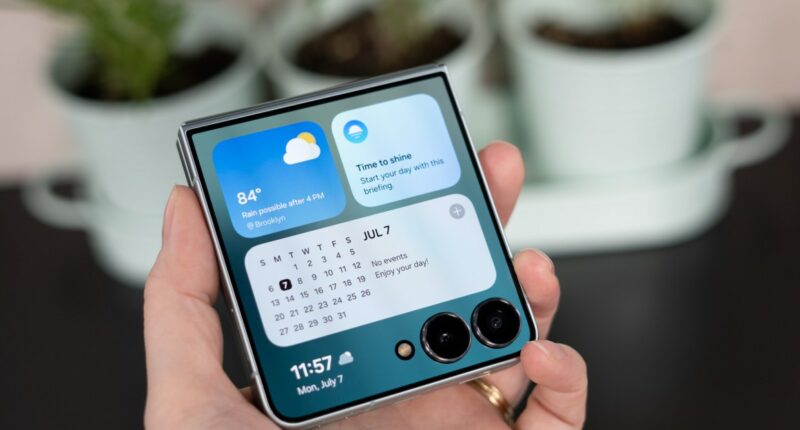Share this @internewscast.com
I carry a variety of phones with me, and it’s not often that people ask about them since the trend of discussing phone models dwindled around 2017. Even if I were wielding an unreleased iPhone 18 Pro Max Air Ultra to pay for a coffee, it probably wouldn’t catch anyone’s attention (besides present company, of course). For most people, a phone is just a phone; regardless of the brand or operating system, they all share a similar size and appearance. That is, unless it’s a flip phone.
Flip phones capture interest from tech enthusiasts who have encountered every mobile device imaginable because they stand out as distinctly different. During the early smartphone era, manufacturers experimented with a range of designs. Whether it was physical keyboards, rotating displays, or retractable cameras, almost anything was considered. Over the past ten years, however, the industry settled on the slab design as the dominant form, a trend that went largely unchallenged until Samsung introduced foldable screens.
Initially, book-style foldable phones hit the market before the newer flip phones. Samsung’s first attempt turned out to be problematic, as reviewers quickly encountered issues with the inner screen. Among them was Dieter Bohn from The Verge, who noticed a small bump where something seemed to be pressing into the screen along the crease. Similar issues were reported by CNBC with their testing device.
Other reviewers found their units also suffered from severe screen failures when they removed the factory-installed screen protector, which was intended to remain in place. If seasoned reviewers could make such an error, it’s likely everyday consumers would too. Although dust wasn’t officially identified as the culprit, and Samsung faced multiple issues, the message was clear: the internal display of folding phones was vulnerable to damage.
The re-launch of flip phones didn’t start smoothly with models like Motorola’s new Razr and Samsung’s initial Flip showing shortcomings. Even with the introduction of a more robust glass screen compared to plastic, both devices presented too many compromises in durability and cost, making them hard to justify as purchases based on novelty alone. The turning point came when Motorola revisited its Razr design and opted for a substantial outer screen instead.
The 2023 Motorola Razr Plus marked a significant step for flip phones, with its large 3.6-inch outer display. Though small, it was the most expansive screen featured on a flip phone at the time, offering enhanced functionality. Users could now do more than just glance at notifications—they could respond to messages, explore their Spotify playlists, and even run full applications. Samsung adopted a similar strategy, eventually eliminating the folder-like displays in favor of full front panels, making flip phones far more practical with comprehensive cover screens. I adore flip phones, and it’s clear many of you do too.
Those little specks of dust still loom large. Despite substantial improvements to the screens and hinges, and the addition of water resistance, flip phones (and their fold-style siblings) still lack dust resistance. Both Motorola and Samsung’s latest foldables come with an IP48 rating, which only guarantees protection against very small particles, meaning anything smaller than a millimeter could still potentially work its way into the phone and wreak havoc.
Sure, plenty of people own folding phones and never experience problems with dust, which is great! But when every other slab-style phone at the same price point comes with a full IP68 rating, it’s hard to tell the average person to go ahead and spend $1,000 on a flip phone. Fun only goes so far.
I had a burning question for Samsung’s head of smartphone planning, Minseok Kang. Maybe it even bordered on a plea. “Is a dustproof foldable even possible?” I asked following Samsung’s most recent Unpacked. “I don’t think that it’s not possible,” he said. “But it is difficult.”
Whispers of foldables with the elusive IP68 rating have cropped up around most of the recent folding phone launches, ultimately fizzling when the full specs have been revealed. But the rumors are firing up again, suggesting that the Google Pixel 10 Pro might come with dust resistance. That, frankly, would rule. But I’ve gotten my hopes up one too many times this year, and I don’t have the energy to do it again, so I’ll consider it a nice surprise if it arrives with dust resistance. But I haven’t given up hope — I have it on good authority that it’s not impossible, after all.
- If you live outside the US, you have a bunch more flip phones to choose from. Oppo, Huawei, and Xiaomi sell flip-style foldables — just not on our shores.
- Samsung and Motorola have both expanded their flip phone portfolios this year. Motorola added a third high-end “Ultra” model, while Samsung recycled the previous generation’s Z Flip design into a lower-cost FE version this year. More models means a bigger spread in pricing, which ranges from $699 to $1,299.
- Nobody’s having more fun with the flip format than Motorola. Razr phones include preloaded games tailored to the outer screen, retro-inspired music for player themes, and a mode that mimics the classic Razr’s UI.
This is The Stepback, a weekly newsletter breaking down one essential story from the tech world. For more on all things phones and consumer tech, follow Allison Johnson. The Stepback arrives in our subscribers’ inboxes at 8AM ET. Opt in for The Stepback here.









